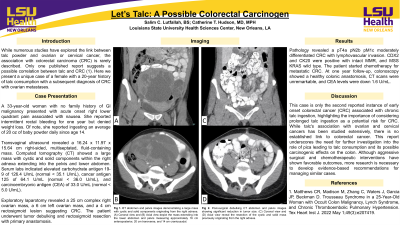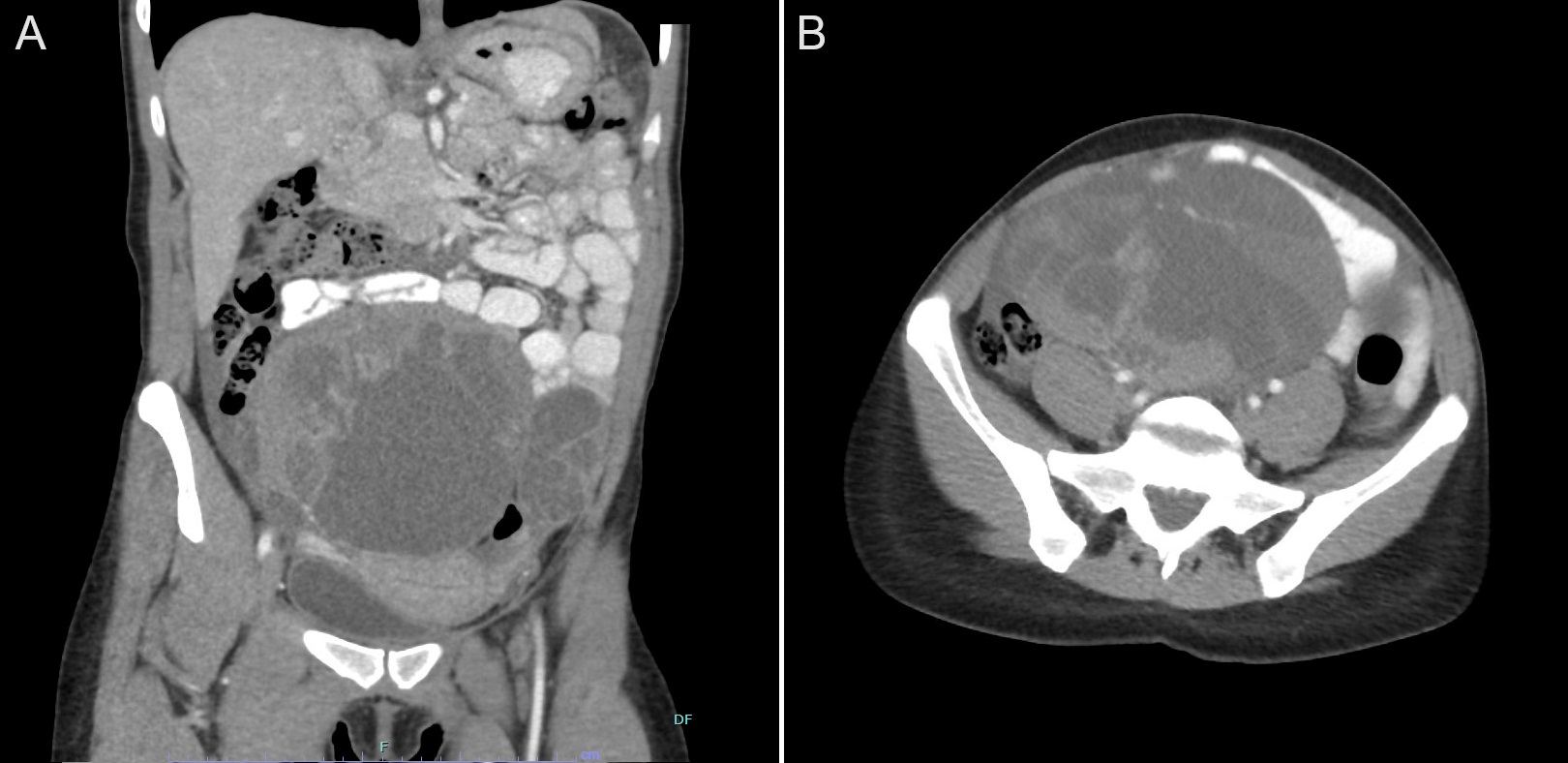Sunday Poster Session
Category: Colorectal Cancer Prevention
P0453 - Let’s Talc: A Possible Colorectal Carcinogen
Sunday, October 27, 2024
3:30 PM - 7:00 PM ET
Location: Exhibit Hall E

Has Audio
.jpg)
Salim C. Lutfallah, BS
LSU Health New Orleans School of Medicine
Metairie, LA
Presenting Author(s)
Salim C.. Lutfallah, BS1, Catherine T.. Hudson, MD, MPH2
1LSU Health New Orleans School of Medicine, Metairie, LA; 2LSU, New Orleans, LA
Introduction: While numerous studies have explored the link between talc powder and ovarian or cervical cancer, the association with colorectal carcinoma (CRC) is rarely described. Only one published report suggests a possible correlation between talc and CRC (1). Here we present a unique case of a female with a 20-year history of talc consumption with a subsequent diagnosis of CRC with ovarian metastases.
Case Description/Methods: A 33-year-old woman with no family history of GI malignancy presented with acute onset right lower quadrant pain associated with nausea. She reported intermittent rectal bleeding for one year but denied weight loss. Of note, she reported ingesting an average of 20 oz of baby powder daily since age 14.
Transvaginal ultrasound revealed a 16.24 x 11.97 x 15.64 cm right-sided, multiseptated, fluid-containing mass. Computed tomography (CT) showed a large mass with cystic and solid components within the right adnexa extending into the pelvis and lower abdomen. Serum labs indicated elevated carbohydrate antigen 19-9 of 126.4 U/mL (normal < 35.1 U/mL), cancer antigen 125 of 64.1 U/mL (normal < 36.0 U/mL), and carcinoembryonic antigen (CEA) of 33.0 U/mL (normal < 5.0 U/mL).
Exploratory laparotomy revealed a 25 cm complex right ovarian mass, a 6 cm left ovarian mass, and a 4 cm rectosigmoid lesion suggesting CRC. The patient underwent tumor debulking and rectosigmoid resection with primary anastomosis.
Pathology revealed a pT4a pN2b pM1c moderately differentiated CRC with lymphovascular invasion. CDX2 and CK20 were positive with intact MMR, and MSS KRAS wild type. The patient started chemotherapy for metastatic CRC.
At one year follow-up, colonoscopy showed a healthy colonic anastomosis, CT scans were unremarkable, and CEA levels were down 1.6 U/mL.
Discussion: This case is only the second that has been reported with both describing early onset CRC in the setting of chronic talc ingestion. This highlights the importance of considering prolonged talc ingestion as a possible risk for CRC as it may be carcinogenic to the colon when ingested. Further investigation into the risk of pica resulting in the consumption of talc powder for the development of early onset CRC.
References:
1. Matthews CR, Madison M, Zhang C, Waters J, Garcia JP, Beckman D. Trousseau Syndrome in a 25-Year-Old Woman with Occult Colon Malignancy, Lynch Syndrome, and Chronic Thromboembolic Pulmonary Hypertension. Tex Heart Inst J. 2022 May 1;49(3):e207419.

Disclosures:
Salim C.. Lutfallah, BS1, Catherine T.. Hudson, MD, MPH2. P0453 - Let’s Talc: A Possible Colorectal Carcinogen, ACG 2024 Annual Scientific Meeting Abstracts. Philadelphia, PA: American College of Gastroenterology.
1LSU Health New Orleans School of Medicine, Metairie, LA; 2LSU, New Orleans, LA
Introduction: While numerous studies have explored the link between talc powder and ovarian or cervical cancer, the association with colorectal carcinoma (CRC) is rarely described. Only one published report suggests a possible correlation between talc and CRC (1). Here we present a unique case of a female with a 20-year history of talc consumption with a subsequent diagnosis of CRC with ovarian metastases.
Case Description/Methods: A 33-year-old woman with no family history of GI malignancy presented with acute onset right lower quadrant pain associated with nausea. She reported intermittent rectal bleeding for one year but denied weight loss. Of note, she reported ingesting an average of 20 oz of baby powder daily since age 14.
Transvaginal ultrasound revealed a 16.24 x 11.97 x 15.64 cm right-sided, multiseptated, fluid-containing mass. Computed tomography (CT) showed a large mass with cystic and solid components within the right adnexa extending into the pelvis and lower abdomen. Serum labs indicated elevated carbohydrate antigen 19-9 of 126.4 U/mL (normal < 35.1 U/mL), cancer antigen 125 of 64.1 U/mL (normal < 36.0 U/mL), and carcinoembryonic antigen (CEA) of 33.0 U/mL (normal < 5.0 U/mL).
Exploratory laparotomy revealed a 25 cm complex right ovarian mass, a 6 cm left ovarian mass, and a 4 cm rectosigmoid lesion suggesting CRC. The patient underwent tumor debulking and rectosigmoid resection with primary anastomosis.
Pathology revealed a pT4a pN2b pM1c moderately differentiated CRC with lymphovascular invasion. CDX2 and CK20 were positive with intact MMR, and MSS KRAS wild type. The patient started chemotherapy for metastatic CRC.
At one year follow-up, colonoscopy showed a healthy colonic anastomosis, CT scans were unremarkable, and CEA levels were down 1.6 U/mL.
Discussion: This case is only the second that has been reported with both describing early onset CRC in the setting of chronic talc ingestion. This highlights the importance of considering prolonged talc ingestion as a possible risk for CRC as it may be carcinogenic to the colon when ingested. Further investigation into the risk of pica resulting in the consumption of talc powder for the development of early onset CRC.
References:
1. Matthews CR, Madison M, Zhang C, Waters J, Garcia JP, Beckman D. Trousseau Syndrome in a 25-Year-Old Woman with Occult Colon Malignancy, Lynch Syndrome, and Chronic Thromboembolic Pulmonary Hypertension. Tex Heart Inst J. 2022 May 1;49(3):e207419.

Figure: Figure 1. CT abdomen and pelvis images demonstrating a large mass with cystic and solid components originating from the right adnexa. (A) Coronal view and (B) Axial view depict the mass extending into the lower abdomen and pelvis measuring approximately 16 cm anteroposterior, 20 cm transverse, and 14 cm craniocaudal.
Disclosures:
Salim Lutfallah indicated no relevant financial relationships.
Catherine Hudson indicated no relevant financial relationships.
Salim C.. Lutfallah, BS1, Catherine T.. Hudson, MD, MPH2. P0453 - Let’s Talc: A Possible Colorectal Carcinogen, ACG 2024 Annual Scientific Meeting Abstracts. Philadelphia, PA: American College of Gastroenterology.

